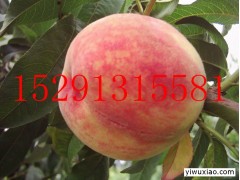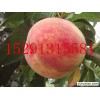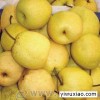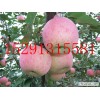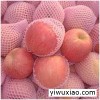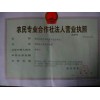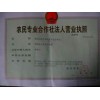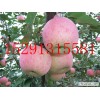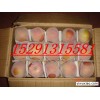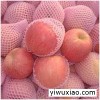形态
落叶小乔木;叶为窄椭圆形至披针形,长15厘米,宽4厘米,先端成长而细的尖端,边缘有细齿,暗绿色有光泽,叶基具有蜜腺;树皮暗灰色,随年龄增长出现裂缝;花单生,从淡至深粉红或红色,有时为白色,有短柄,直径4厘米,早春开花;近球形核果,表面有毛茸,肉质可食,为橙黄色泛红色,直径7.5厘米,有带深麻点和沟纹的核,内含白色种子。
[编辑]品种
桃有多种品种,一般果皮有毛,“油桃”的果皮光滑;“蟠桃”果实是扁盘状;“碧桃”是观赏花用桃树,有多种形式的花瓣,北京植物园还有几百个不同的品种。
食用的桃还有久保桃、水蜜桃、绿化九、十四号、白凤等不同品种。[1]
[编辑]种植
port</d>ant; width: 222px; ">port</d>ant; text-align: left; ">port</d>ant; background-image: none !<d>import</d>ant; float: right; background-position: initial initial !<d>import</d>ant; background-repeat: initial initial !<d>import</d>ant; ">port</d>ant; vertical-align: middle; display: block; background-image: none !<d>import</d>ant; " />碧桃桃是一种温带植物,需要一定的夏日光照但晚上要比较凉爽的气温及充足的水分和肥料,而且不耐旱。一般用嫁接法种植。把树型要修整为张开的手掌形以使各部分能获得充分的阳光(和苹果要有一个向上的中心领导枝不同),桃园和苹果园可以从树型上很容易地区别。
[编辑]历史
port</d>ant; width: 222px; ">port</d>ant; text-align: left; ">port</d>ant; background-image: none !<d>import</d>ant; float: right; background-position: initial initial !<d>import</d>ant; background-repeat: initial initial !<d>import</d>ant; ">port</d>ant; vertical-align: middle; display: block; background-image: none !<d>import</d>ant; " />火王子品种桃port</d>ant; width: 222px; ">port</d>ant; text-align: left; ">port</d>ant; background-image: none !<d>import</d>ant; float: right; background-position: initial initial !<d>import</d>ant; background-repeat: initial initial !<d>import</d>ant; ">port</d>ant; vertical-align: middle; display: block; background-image: none !<d>import</d>ant; " />桃子的剖面port</d>ant; width: 222px; ">port</d>ant; text-align: left; ">port</d>ant; background-image: none !<d>import</d>ant; float: right; background-position: initial initial !<d>import</d>ant; background-repeat: initial initial !<d>import</d>ant; ">port</d>ant; vertical-align: middle; display: block; background-image: none !<d>import</d>ant; " />桃的7个半月成熟过程,从早冬到仲夏,拍摄于澳大利亚维多利亚州东吉普斯兰。桃原产于中国,最远可以追溯到周朝,《诗经·国风·周南》即有《桃夭》一诗,逐渐传播到亚洲周边地区,从波斯传入西方, 桃的拉丁名称Persica 意思就是波斯。
[编辑]文化
port</d>ant; width: 222px; ">port</d>ant; text-align: left; ">port</d>ant; background-image: none !<d>import</d>ant; float: right; background-position: initial initial !<d>import</d>ant; background-repeat: initial initial !<d>import</d>ant; ">port</d>ant; vertical-align: middle; display: block; background-image: none !<d>import</d>ant; " />春节时摆放的贺年桃花桃在亚洲文化中占很大的地位,中国古代传说经常提到桃是一种可以延年益寿的水果,神仙多食用桃,《西游记》中孙悟空看管的桃园,出产的桃子人吃了可以立刻成仙[2]。日本神话中有“桃太郎”。
桃木在中国文化中有避邪的意义[3],相传东海东少山上住着神荼、郁垒二位神仙,手持桃枝,专司捉妖拿邪。通常在门外挂有桃木符或桃木做的对联[4]。《淮南子·诠言》说:“羿死于桃口”。许慎注:“口,大杖,以桃木为之,以击杀羿,由是以来鬼畏桃也”。战国楚人认为桃树是可以驱鬼辟邪[5]。《棘楚岁时记》记载南朝楚地风俗:“元旦服桃汤,桃者五行之精,能厌服邪气,制御百鬼。”“正月一日……造桃板著户,谓之仙木,百鬼所畏。”《晋书·礼志》记晋代:“岁旦,常设苇索、桃梗、磔鸡于宫及百寺之门以禳恶气。”《本草纲目》说:“桃味辛气恶,故能厌邪气”。道士做法时亦常用桃木剑降妖伏魔,《封神榜》载姜子牙用桃木剑降妖兴周。
桃花在中国文化中则多与爱情、人缘相关,《诗经·国风·周南·桃夭》云:“桃之夭夭,灼灼其华,之子于归,宜室宜家”,这是一首送新嫁娘歌,用美丽的桃花比喻新娘。春节时会摆放桃花以求行桃花运,参见犯桃花词条。而“桃”与“图”于粤语和部份南方方言同音,春节时做生意的人亦喜欢于家中或公司摆放大棵桃花,取其“大展鸿图”之意。另外在中国形容男同性恋者的其中一个成语为“断袖分桃”[6]。






